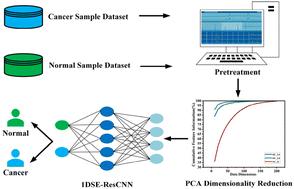Our official English website, www.x-mol.net, welcomes your
feedback! (Note: you will need to create a separate account there.)
An improved cancer diagnosis algorithm for protein mass spectrometry based on PCA and a one-dimensional neural network combining ResNet and SENet
Analyst ( IF 3.6 ) Pub Date : 2024-11-04 , DOI: 10.1039/d4an00784k Liang Ma, Wenqing Gao, Xiangyang Hu, Dongdong Zhou, Chenlu Wang, Jiancheng Yu, Keqi Tang
Analyst ( IF 3.6 ) Pub Date : 2024-11-04 , DOI: 10.1039/d4an00784k Liang Ma, Wenqing Gao, Xiangyang Hu, Dongdong Zhou, Chenlu Wang, Jiancheng Yu, Keqi Tang

|
Cancer is one of the most serious health problems worldwide. Because cancer has no specific symptoms in its early stages, it is often not diagnosed until it is in advanced stages, reducing the likelihood of successful treatment. Therefore, early diagnosis of cancer is a formidable challenge. Mass spectrometry-based proteomics offers a robust technical foundation for cancer diagnosis. However, mass spectrometry data are characterized by high dimensionality, large data volume, and noise interference, which can lead to diagnostic errors in clinical applications. To address this challenge, an improved algorithm combining principal component analysis (PCA) with a convolutional neural network (CNN) algorithm (denoted as PCA-1DSE-ResCNN) was proposed to assist in analyzing high-dimensional mass spectral data. The algorithm initially reduced the dimensionality of the data through the PCA technique. Subsequently, the convolutional neural network algorithm (1DSE-ResCNN) integrating residual blocks and squeeze-and-excitation blocks was used as a classifier. This approach can not only alleviate the issues of overfitting and gradient vanishing caused by deep network layers but also reduce redundant information, enabling the algorithm to effectively learn high-dimensional data features and deal with nonlinear relationships. To validate the effectiveness of the algorithm, the high-dimensional ovarian cancer mass spectrometry dataset was selected as an example to examine its application performance in early diagnosis of ovarian cancer. The experimental results demonstrated that the PCA-1DSE-ResCNN algorithm outperforms other methods in terms of accuracy, specificity, and sensitivity on three high-dimensional ovarian cancer datasets. This study will contribute to the rapid diagnosis and early detection of cancer.
中文翻译:

一种基于 PCA 和结合 ResNet 和 SENet 的一维神经网络的蛋白质质谱改进癌症诊断算法
癌症是全球最严重的健康问题之一。由于癌症在早期没有特异性症状,因此通常直到晚期才被诊断出来,从而降低了成功治疗的可能性。因此,癌症的早期诊断是一项艰巨的挑战。基于质谱的蛋白质组学为癌症诊断提供了强大的技术基础。然而,质谱数据具有维数高、数据量大、噪声干扰等特点,在临床应用中可能导致诊断错误。为了应对这一挑战,提出了一种将主成分分析 (PCA) 与卷积神经网络 (CNN) 算法(表示为 PCA-1DSE-ResCNN)相结合的改进算法,以协助分析高维质谱数据。该算法最初通过 PCA 技术降低了数据的维度。随后,使用集成残差块和挤压激励块的卷积神经网络算法 (1DSE-ResCNN) 作为分类器。这种方法不仅可以缓解深度网络层引起的过拟合和梯度消失问题,还可以减少冗余信息,使算法能够有效地学习高维数据特征并处理非线性关系。为了验证该算法的有效性,以高维卵巢癌质谱数据集为示例,考察其在卵巢癌早期诊断中的应用性能。实验结果表明,PCA-1DSE-ResCNN 算法在三个高维卵巢癌数据集上的准确性、特异性和敏感性优于其他方法。 这项研究将有助于癌症的快速诊断和早期发现。
更新日期:2024-11-04
中文翻译:

一种基于 PCA 和结合 ResNet 和 SENet 的一维神经网络的蛋白质质谱改进癌症诊断算法
癌症是全球最严重的健康问题之一。由于癌症在早期没有特异性症状,因此通常直到晚期才被诊断出来,从而降低了成功治疗的可能性。因此,癌症的早期诊断是一项艰巨的挑战。基于质谱的蛋白质组学为癌症诊断提供了强大的技术基础。然而,质谱数据具有维数高、数据量大、噪声干扰等特点,在临床应用中可能导致诊断错误。为了应对这一挑战,提出了一种将主成分分析 (PCA) 与卷积神经网络 (CNN) 算法(表示为 PCA-1DSE-ResCNN)相结合的改进算法,以协助分析高维质谱数据。该算法最初通过 PCA 技术降低了数据的维度。随后,使用集成残差块和挤压激励块的卷积神经网络算法 (1DSE-ResCNN) 作为分类器。这种方法不仅可以缓解深度网络层引起的过拟合和梯度消失问题,还可以减少冗余信息,使算法能够有效地学习高维数据特征并处理非线性关系。为了验证该算法的有效性,以高维卵巢癌质谱数据集为示例,考察其在卵巢癌早期诊断中的应用性能。实验结果表明,PCA-1DSE-ResCNN 算法在三个高维卵巢癌数据集上的准确性、特异性和敏感性优于其他方法。 这项研究将有助于癌症的快速诊断和早期发现。































 京公网安备 11010802027423号
京公网安备 11010802027423号